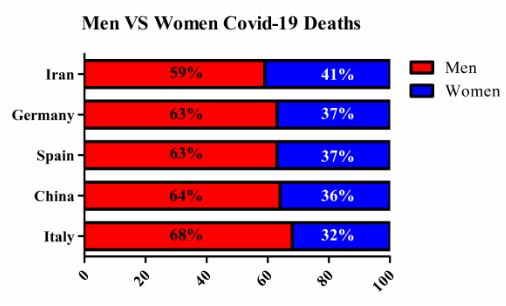Women are Less Vulnerable to Covid-19 than Men; a strategy to Reduce the Fatality Rate in Men
Muhammad ZK1*, Adnan K1, Khurshied AK2, Asma N2 and Ibrar MK3
1College of Animal Science and Technology, China Agricultural University, Beijing 100193, R. China
2Ghazi University DG Khan, 32200 Pakistan
Received Date: 20/07/2020; Published Date: 15/09/2020
*Corresponding author: Khurshied Ahmed Khan, Ghazi University DG Khan 32200 Pakistan. E-mail: kakhan@gudgk.edu.pk
Letter to Editor
COVID-19 is an outbreak that initially appeared in Wuhan, Hubei Province, China, in December 2019, but it has already turned into a highly contagious pandemic worldwide [1,2].This virus can affect both men and women. However, available data suggests that men seem to represent the majority of deaths worldwide, even though globally men and women contract the virus in relatively equal numbers. According to the survey findings from the academic research group Global Health 50/50, determined that men are more likely than women to die of the coronavirus in many countries especially, places (Italy, China, Germany, Spain, and Iran) with most severe outbreaks [3].(Figure 1).

Figure 1: Covid-19 mediated fatality ratio between men and women.
Now a question arises that what are the possible physiological, genetic and, behavioral adaptations that make women less susceptible to this disease? One of the possible reasons is that females mount a stronger immune response to viral infections compared with males as the result of more robust harmonal and cellular immune response [4].Female sex hormone Estrogen is considered to have antiviral properties viabinding to intracellular, genomic estrogen receptors (ERs), such ERα (ESR1) and ERβ (ESR2) present in upper and lower respiratory tract reduce Influenza A virus titers in human nasal epithelial cells from females [5].Likewise, previous study about H1N1 pandemic influenza indicated higher mortality in pregnant women due to lower levels of estrogens [6]. In contrast, lower levels of estrogens and higher levels of androgens in influenza-infected males were linked to immune-suppression [7].Moreover, Women have two copies of a X chromosome while men have only a single X chromosome and a small Y chromosome that contains few genes.Many immunity-related genes regulating innate and adaptive immune systems are linked with X chromosomes. A study found that genes on the X chromosome female mice less susceptible to SARS [8] (The new coronavirus shares 79.5% of its genetic code with SARS).
Furthermore, some behavioral factors make women less vulnerable to severe cases to COVID-19 including smoking. Comparatively, men smoke more than women do. On average, more than 50% of Chinese men smoke, while less than 3% of Chinese women smoke. Similarly, In Italy, around 7 million men smoke compared to 4.5 million women. Previous studies have shown that smokers are twice more likely than non-smokers to contract influenza and have more severe symptoms. At the same time, smokers were also noted to have higher mortality in the previous MERS-CoV outbreak [9,10]. A recent study on COVID-19 found that smoking is most likely associated with the negative progression and adverse outcomes of COVID-19 patients.
In conclusion, based on the available findings, we can postulate that Estrogen hormone and pair of X chromosomes in females makes them less susceptible to COVID-19 than men. Furthermore, Estrogen can be used as a drug to reduce the vulnerability and fatality in men due to COVID-19.
References:
- Wu JT, Leung K, Leung GM. Nowcasting and forecasting the potential domestic and international spread of the 2019-nCoV outbreak originating in Wuhan, China: a modelling study. Lancet. 2020;395(10225):689-697. doi:10.1016/S0140-6736(20)30260-9.
- Li Q, Guan X, Wu P, et al. Early transmission dynamics in Wuhan, China, of novel coronavirus–infected pneumonia. NEngl J Med. 2020.doi:10.1056/NEJMoa2001316
- Soumitra Ghosh and Robyn S. Klein.Sex Drives Dimorphic Immune Responses to viral infections.The journal of immunology. 2020.
- Jackye Peretz, Andrew Pekosz, Andrew P. Lane, and Sabra L. Klein.Estrogenic compounds reduce influenza A virus replication in primary human nasal epithelial cells derived from female, but not male, donors. Am J Physiol Lung Cell Mol Physiol.2016; 310: 415–425.
- Klein, S. L., A. Hodgson, and D. P. Robinson. Mechanisms of sex disparities in influenza pathogenesis. J. Leukoc. Biol. 2012; 92: 67–73.
- Hoffmann J, A. Otte S, Thiele, H Lotter, Y Shu, and G. Gabriel. 2015. Sex
differences in H7N9 influenza A virus pathogenesis. Vaccine 2015; 33: 6949–6954. - Rudragouda Channappanavar, Craig Fett, Matthias Mack, Patrick P Ten Eyck, David K Meyerholz, and Stanley Perlman.Sex-based differences in susceptibility to SARS-CoVinfection.JImmunol. 2017; 198(10): 4046–4053.
- Park JE, Jung S, Kim A. MERS transmission and risk factors: a systematic review. BMC Public Health. 2018;18(1):574. doi:10.1186/s12889-018-5484-8.
- Constantine I. Vardavas, Katerina Nikitara. COVID-19 and smoking: A systematic review of the evidence. Tobacco Induced Diseases.2020;18:20.

